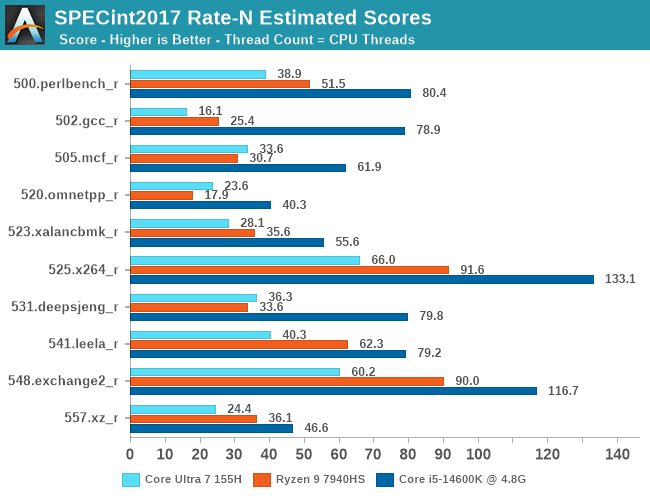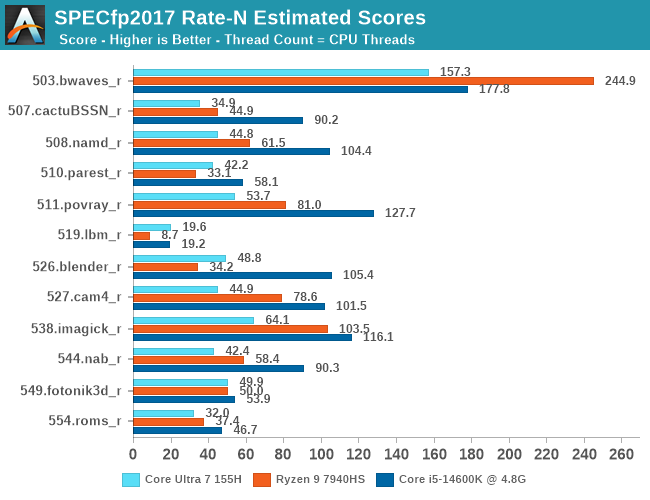The Intel Core Ultra 7 155H Review: Meteor Lake Marks A Fresh Start To Mobile CPUs
by Gavin Bonshor on April 11, 2024 8:30 AM ESTSPEC2017 Single And Multi-Threaded Results
Update 04/12/24: We are currently re-running SPEC2017 on the Intel Core i5-14600K, and we will update the results accordingly once we have them. Apologies for any inconvenience.
SPEC2017 is a series of standardized tests used to probe the overall performance between different systems, different architectures, different microarchitectures, and setups. The code has to be compiled, and then the results can be submitted to an online database for comparison. It covers a range of integer and floating point workloads, and can be very optimized for each CPU, so it is important to check how the benchmarks are being compiled and run.
We run the tests in a harness built through Windows Subsystem for Linux, developed by Andrei Frumusanu. WSL has some odd quirks, with one test not running due to a WSL fixed stack size, but for like-for-like testing it is good enough. Because our scores aren’t official submissions, as per SPEC guidelines we have to declare them as internal estimates on our part.
For compilers, we use LLVM both for C/C++ and Fortan tests, and for Fortran we’re using the Flang compiler. The rationale of using LLVM over GCC is better cross-platform comparisons to platforms that have only have LLVM support and future articles where we’ll investigate this aspect more. We’re not considering closed-source compilers such as MSVC or ICC.
clang version 10.0.0
clang version 7.0.1 (ssh://git@github.com/flang-compiler/flang-driver.git
24bd54da5c41af04838bbe7b68f830840d47fc03)
-Ofast -fomit-frame-pointer
-march=x86-64
-mtune=core-avx2
-mfma -mavx -mavx2
Our compiler flags are straightforward, with basic –Ofast and relevant ISA switches to allow for AVX2 instructions.
To note, the requirements for the SPEC license state that any benchmark results from SPEC have to be labeled ‘estimated’ until they are verified on the SPEC website as a meaningful representation of the expected performance. This is most often done by the big companies and OEMs to showcase performance to customers, however is quite over the top for what we do as reviewers.

Starting with the single-threaded results in SPECint2017 and comparing the Intel Core Ultra 7 155H directly to AMD's Ryzen 9 7940HS processor, we can see that both chips are relatively competitive for the most part. Since Intel's Core Ultra 7 155H is based on their Meteor Lake SoC with the compute tile built on the latest Intel 4 process, Intel has done a good job of ensuring parity with the competition. Even though the Core Ultra 7 155H is technically an SoC, it remains competitive in the SPECint2017 section of our single-thread testing against the Ryzen 9 7940HS. The AMD chip performs better in two of the tests (525.x264_r and 548.exchange2_r); on the whole, Intel is competitive.
In order to try to keep things a little more apples-to-apples in this architecture-centric benchmark set, we've capped the Intel Core i5-14600K to the same boost core frequencies as the Core Ultra 7 155H (4.8 GHz P-Core and 3.8 GHz E-Core), as well as explicitly enforcing Intel's stock power specifications to avoid motherboard boosting via Multi-Core Enhancement. Doing so, we see similar levels of single-threaded performance as the other chips.

In the second section of our single-threaded testing, we again see a very competitive showing in SPECfp2017 between the Intel Core Ultra 7 155H and the AMD Ryzen 9 7940HS. The only test we see a major gain for the Ryzen 9 7940HS is in the 503.bwaves_r test, which is a computational fluid dynamics (CFD) simulation.

Moving onto the multi-threaded section of our SPEC2017 testing, things get considerably different. First of all, the Intel Core Ultra 7 155H has more cores than the Ryzen 9 7940HS (6P+8E+2LP vs. 8C), but ultimately, the Ryzen 9 7940HS uses more of the bigger cores. The Core Ultra 7 155H resembles the U-series Phoenix-based AMD chips like the Ryzen 7 7840U. Taking that into consideration, we can see that the Ryzen 9 7940HS performs considerably better than the Core Ultra 7 155H in the multi-threaded tests, with wins in all but two of the tests, which are 502.gcc_r and 505.mcf_r, where Intel gets modest wins. In this area, the Intel Core i5-14600K has superior multi-threaded performance, but as it is a chip built on a fully desktop architecture, this is expected.
Analyzing the Core i5-14600K in relation to the Core Ultra 7 155H, we see the desktop variant of Raptor Lake consistently outperforming the chips. Even with our frequency capping, the desktop chip's power and cooling advantage can't be completely nullified, so while it provides a useful baseline, Core Ultra isn't going to beat a 125 Watt desktop chip in multi-threaded workloads any time soon – especially when Core Ultra still has to worry about being energy efficient overall.

In the second section of our SPEC2017 MT testing, the SPECfp2017 section also shows more wins for AMD than Intel. In the 503.bwaves_r (CFD) test, the Ryzen 9 7940HS is around 35% ahead of the Core Ultra 7 155H. Intel's Meteor Lake SoC does take wins in the 519.lbm_r and 526.blender_r tests and is competitive in a couple of the tests, but overall, the Ryzen 9 7940HS has more in terms of multi-threaded performance across the majority of the SPEC2017 MT suite.
It's also worth noting here that for our SPEC2017 testing, unlike desktop chips with motherboard vendors looking to outdo each other in performance, it inherently allows for more power to be given to the processor. We are at the whim of tighter power constraints in the case of mobile processors, including notebooks. In a light and thin notebook, such as the ASUS Zenbook 14 OLED UX3405MA, which we are using for our testing, there are both power and thermal constraints to deal with, and it does reflect somewhat in our testing. We can only test with what we have at hand within the range of capabilities the delivery vehicle offers us.










69 Comments
View All Comments
Dante Verizon - Thursday, April 11, 2024 - link
Too strange... in the spec2017 test that represents Blender MeteorLake wins but in the real Blender test it loses? GreatDante Verizon - Thursday, April 11, 2024 - link
The iGPU performance of desktop APUs is also abnormally low.Gavin Bonshor - Friday, April 12, 2024 - link
Could you please elaborate? Did another publication's results land higher? Did they run JEDEC memory settings?ballsystemlord - Thursday, April 11, 2024 - link
That near 50% increase in DRAM access latency coupled with the higher thermal limitations is probably what's holding the 115H back.Ryan Smith - Thursday, April 11, 2024 - link
Keep in mind that they're different workloads with different versions of Blender. The version in SPEC2017 is from 7 years ago, which was the Blender 2.7 era.mode_13h - Monday, April 15, 2024 - link
spec2017 is using an old version of Blender that's frozen in time. That's needed to make all spec2017 results comparable with each other.In the individual Rendering benchmarks, Gavin used a reasonably current version of Blender (3.6 is a LTS release from June 27, 2023), probably also built with a different compiler.
Hulk - Thursday, April 11, 2024 - link
"AMD Arc" in GPU specs?Gavin Bonshor - Friday, April 12, 2024 - link
Yeah, that was a really weird one. It has since been corrected.Fozzie - Thursday, April 11, 2024 - link
Why is the text seemingly out of line with the actual results? Repeatedly it is describing wins for the U7 155H that don't seem to be backed up in the actual benchmarks. For example:"As we can see from our rendering results, the Intel Core Ultra 7 155H is very competitive in single-threaded performance and is ahead of AMD's Zen 4 mobile Phoenix-based Ryzen 9 7940HS."
Actually, the graphs don't show a single instance of the Ultra 7155H besting the Ryzen 9 7940HS in ALL of the preceding graphs.
"Looking at performance in our web and office-based testing, in the UL Procyon Office-based tests using Microsoft Office, the Core Ultra 7 155H is actually outperforming the AMD Ryzen 9 7940HS, which is a good win in itself."
How is 6,792 greater than 7,482? How is 6,978 higher than 7,162?
Did the benchmarks get updated after the text was written? Did someone write the summary text and not pay attention to "Higher is better" vs "Lower is better"?
phoenix_rizzen - Thursday, April 11, 2024 - link
The text describing the Spec tests are also incorrect."Even though the Core Ultra 7 155H is technically an SoC, it remains competitive in the SPECint2017 section of our single-thread testing against the Ryzen 9 7940HS. The AMD chip performs better in two of the tests (525.x264_r and 548.exchange2_r); on the whole, Intel is competitive."
Except the graph shows the AMD system beating the Intel system in 7 tests and only losing by a small margin in 3 of them. The AMD system even beats the Intel desktop system in 4 tests and ties it in 1.
"In the second section of our single-threaded testing, we again see a very competitive showing in SPECfp2017 between the Intel Core Ultra 7 155H and the AMD Ryzen 9 7940HS. The only test we see a major gain for the Ryzen 9 7940HS is in the 503.bwaves_r test, which is a computational fluid dynamics (CFD) simulation."
Except the AMD system wins in 4 tests, essentially ties in 5 tests, and only loses in 2. It even beat the desktop system in 3 tests.
The text is nowhere near consistent with the graphs.